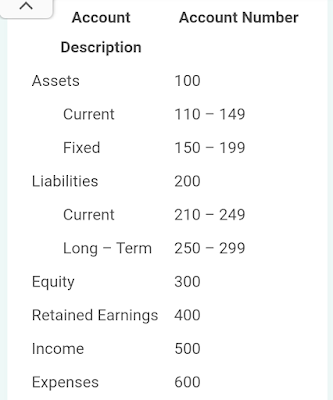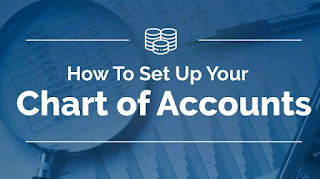What Is a Chart of Accounts?
"For every minute you spend organizing, there is an hour earned," as the saying goes. When it comes to accounting, taking the time to get organized can save you a lot of time and money in the long run. That's why you'll need your chart of accounts (COA), your go-to organizational accounting tool.
In this article, you will understand the meaning of a chart of accounts, how to set it up and their importance.
What Is A Chart Of Accounts?
A chart of accounts can be defined as an organized list of all of your company's accounts. It gives you a bird's eye perspective of every part of your company that spends or earns money. The most common types of accounts in chart of accounts include assets, liabilities, equity, expenses and revenue.
By recording all of the accounts engaged in your business' day-to-day activities, the COA should offer anyone looking at it a rough notion of the nature of your organization.
What Are The 5 Types Of Accounts?
In accounting, the five types of accounts are:
- Assets account
- Liabilities account
- Income (Revenue) account
- Expenses account
- Equity account
1. Asset account
So, what exactly are assets? Assets are properties of a business. They are tangible and intangible things that your company owns and add economic value to your business. Examples of assets are land and building, motor vehicles, stock of goods, plant and machinery, furniture and fittings, etc.
There are two types of assets, namely: current and non-current (fixed) assets. Current assets are items of value that are temporary in nature and do not last for a long time, usually one year or less than one year. Examples of current assets are cash, accounts receivable, etc. On the other hand, a non-current asset is a long-term asset that generally doesn’t convert into cash within one year. Examples of non-current assets are furniture and fittings, land and buildings, etc.
Recording transactions involving assets: An increase in assets should be debited while a decrease in assets should be credited.
Assets of a business are calculated by:
Assets = liabilities + capital
2. Liability account
What are liabilities? Liabilities are debts that a business owes to outsiders. They are what a business owes. Examples of liabilities are loans, creditors and accounts payable.
You may have short-term or long-term liabilities. Liabilities that are short-term, or current, are obligations that are expected to be paid within a year, such as accounts payable. Long-term liabilities, also known as non-current liabilities, are obligations that take longer than a year to repay, such as a business loan.
Recording transactions involving liabilities: An increase in liability must be credited while a decrease in liability must be debited
A business liabilities are calculated by Liabilities = assets - capital
Read our article on the differences between assets and liabilities
3. Equity account
Your equity tells you how much money your company is worth. You may calculate your business equity by deducting your liabilities from your assets. The more your liabilities, the less your equity.
Recording transactions: Credit increase in equity and debit decrease in equity.
Business equity is calculated by:
Business equity = Assets - Liabilities
4. Income account
Business income, often known as revenue, is the money your company makes from operations (e.g., sales of product) or non-operations (e.g., interest). So, if your company makes a profit, record the transactions in your income accounts.
Recording transactions: Debits decrease income while credits increase income
5. Expense account
Last but not least is expenses account. The expense account is where you record your company's expenditures. Expenses are the costs you incur when running your business, such as advertising and wages.
Recording transactions: Credits decrease expenses while debits increase them.
Chart Of Accounts List
Now that you've learned what a chart of accounts is, it's time to learn how it operates. Sub-accounts are created when transactions are recorded. The five major accounts (assets, liabilities, capital, income and expenses) are then divided into sub-accounts. The sub-accounts to use are determined by the nature of your business.
So, how should your accounting chart of accounts be structured? Notwithstanding that the sub-accounts you use may differ, here's an example of a chart of accounts list and how it might be organized:
Assets account
- Account receivables
- Checking
- Furniture
- Plant and machinery
- Debtors
Liabilities account
- Sales Tax Collected
- Accounts Payable
- Payroll Tax Liability
- Loans
- Creditors
Equity account
- Owner’s Equity
- Retained earnings
- Additional paid in capital
Income account
- Bank Account Interest
- Miscellaneous Income
- Product XYZ Sales
Expenses account
- Advertising
- Payroll Expense
- Equipment
- Office Supplies
- Insurance
A COA can help you stay organized, making your accounting books clean and understandable, irrespective of the sub-accounts you decide to use. This way, you won't have to list every transaction under one of the five primary accounts. Rather, you group them together under their relevant sub-accounts.
How To Set Up A Chart Of Accounts
Since you know what a chart of accounts is and how to list them, it is very important that you know how to create one.
The best chart of accounts structure should have five categories. Each of the five types of accounts should be assigned a group of numbers. Then assign a number to each account that corresponds to the group that it belongs to.
Your assets, for example, range from 100 to 199. Since cash falls under the asset category, you'd list it in the 100s.
You can choose a numbering scheme that is most appropriate for your company. You might utilize smaller numbers than a huge organization, depending on the size of your company (for example, 3 digits vs. 4 digits). Your COA might look something like this:
 |
| Sample chart of accounts |
Large businesses, on the other hand, are more likely to use four-digit numbers (example, 1000) for their chart of accounts. If your company expands significantly, you will almost certainly need to add more numbers.
Make sure your COA numbering makes sense to you, regardless of how it's done. The numbers are there to help you keep track of your transactions. A combination of letters and digits is used by some small business owners (e.g., A100).
Between accounts, leave blank numbers to allow you to add to them later. Keep your accounts constant so you can compare the financial health of your company from year to year.
Chart Of Accounts Example
Here's a sample chart of accounts to help you understand it:
 |
| Sample chart of accounts |
Why Is The Chart Of Accounts Important?
Unless you know the names of all the accounts in your books by heart, you should have them always in front of you.
- The COA is intended to serve as a gateway to every part of your company's financial statements without stress.
- A COA that is well-designed should clearly divide all of the company's most essential accounts and make it simple to determine which transactions go into which account.
- It should help you make smarter decisions, provide an accurate picture of the financial health of your business, and make financial reporting standards easier to comply with.











